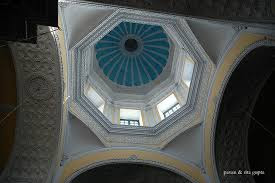 |
| Our Lady of Graces,minor Basilic, Sardhana, near Meerut, UP. India.en. wikipedia. org |
 |
| Tourist Places in Uttar Pradesh.www.maps-india.com |
 |
| Sardhana - interior dome. Our Lady of Graces, main alter of Basilica.www.flickr.com |
 |
| Sardhana - Our Lady of Graces, main alter of Basilica en. wikipedia.org |
The church with its tall steeples and gothic architecture is noticeable from a distance and the strikingly beautiful, serene statue of Jesus Christ, with his arms spread out in a welcoming gesture, welcomes visitors towards the historical church singularly built by a Muslim woman. This suggests religion has nothing to do with one's dedication or love for Jesus Christ or Lord Krishna or the great Buddha.
 |
| Sardhana - Our Lady of Graces, main alter of Basilica en. wikipedia.org |
The date of beginning of the construction of this church is a matter of controversy. A famous lawyer and one of the framers of Indian constitution Shri. K. M. Munshi, suggested the date as 1809, whereas Fr. Keegan, in his study of the Begum, gave a date of 1820. After some representation from the Begum, Pope Gregory XVI established the Apostolic Vicariate of Sardhana from the Apostolic Vicariate of Tibet-Hindustan and appointed Bishop Julius Caesar Scotti as the Apostolic Vicar later merged with the Apostolic Vicariate of Agra. After 1822 the church became a cathedral for a short time, with its own bishop. The Bishop's Palace has become now a girls school. Samru's original palace has now become a seminary for training priests.
Begum Samru inherited the Jagir of Sardhana after her husband's death in 1778. Subsequently, she made up her mind to build a wonderful Church at Sardhana, dedicated to Virgin Mary. She had spent, it is believed, 4 lakhs of rupees, a huge amount in those days.
This beautiful church, whose architect was an Italian in the Begum's service named Antonio Reghellini is the largest in North India and the style is based upon St Peter's in Rome with a touch of Palladio for Reghellini was a native of Vicenza. He also blended Indian architectural design. Reghellini completed the church in 11 years.
Semi precious stone work, a Greek colonnaded veranda, an elevated altar with a stained glass dome, two spires and three Roman domes enhance the beauty and grandeur. of this church The interior of the church is beautiful beyond description and is simply a model of very highest craftsmanship. Marble rock is entirely used although there are colored rocks just like the Taj used at selected places by the architect. The illuminated octagonal dome was built in such a way the sun light appears to stream through the center.
In the sanctuary there is a Begum's tomb - a majestic 18 feet high building. The sculpture depicts Begum Samru on the throne, smoking a hookah with Europeans and Indians in audience. It was designed by the Italian sculptor Adamo Tadolini and was transported to Sardhana from Italy to Kolkata by ship and by boats and bullock carts from there to this small, dusty town. It was indeed a strenuous job in those days. It depicts the begum with a scroll from Emperor Shah Alam II bestowing upon her the fiefdom of Sardhana after her husband's death. Also depicted are her adopted son David Dyce Sombre and her Diwan, Rae Singh who happened to be the great-grandfather of Motilal Nehru, father of Jawahar Lal Nehru, first prime minister of India.
Tit-Bits:
01. The small town of Sardhana is accessible by road from Meerut city, which is 22 km away. The nearest railway station is Meerut, while the nearest airport is at Delhi (104 km).
02. 45 minutes drive from Meerut to reach the town of Sardhana. Driving through the fertile fields of mustard and sugarcane, interspersed with mango orchards, on a bumpy road to this small town will be good experience for strangers.
03. The right time to visit would be between November and March. On the second Sunday of November every year pilgrims line up there with their wishlist.
04. The first church evr built by a Muslim woman.
05. Begum Samru, a catholic convert, born as Farzana Zebunisa in 1751, and considered to be the only Catholic ruler, that too woman in India.
06. The historical church is the only minor basilica in North India.
07. Sardhana is also famous for Maulana Sadiq Husain Sardhanwi, a scholar and novilist of Urdu literature.
Ref:
Christian missions in north India, 1813–1913: a case study of ... - Page 74
"A queen's magnificent church". The Indian Express. September 3, 2012.
http://www.sardhana.org.uk/basilica.html
http://www.tribuneindia.com/2007/20071111/spectrum/main5.html
https://en.wikipedia.org/wiki/Basilica_of_Our_Lady_of_Graces
https://en.wikipedia.org/wiki/Sardhana









